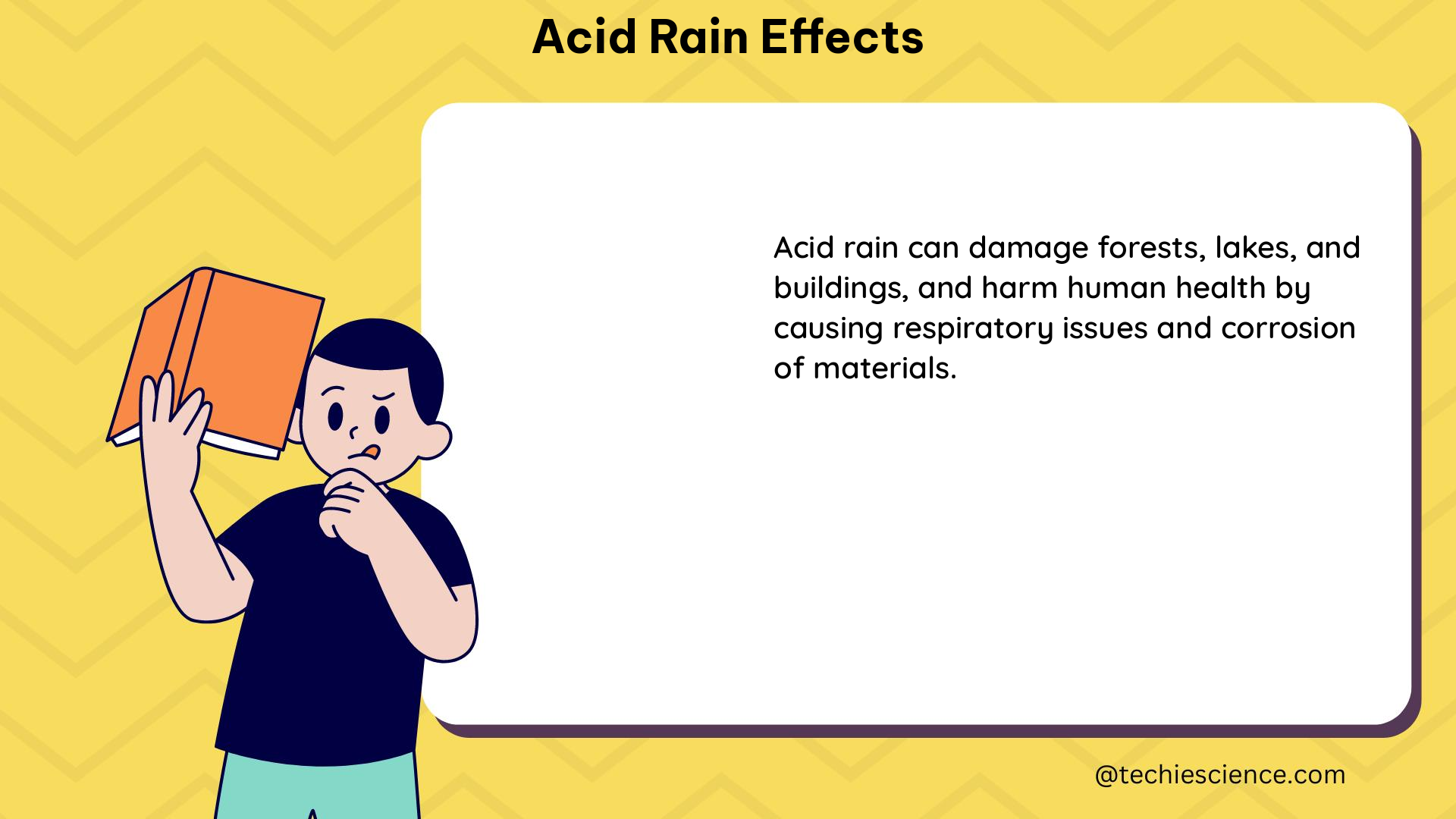Acid rain is a significant environmental issue that has far-reaching consequences on various aspects of our ecosystem. From degrading water quality to damaging soil health and ecosystems, the effects of acid rain are both measurable and quantifiable. This comprehensive guide delves into the intricate details of how acid rain impacts our world, providing a valuable resource for science students and enthusiasts alike.
The Impact of Acid Rain on Water Quality
Acid rain can dramatically alter the pH levels of lakes, streams, and other water bodies, making them more acidic. This increase in acidity can have severe consequences for aquatic life. Let’s explore the specific data points and quantifiable effects:
-
pH Levels: A study conducted in the Adirondack Mountains of New York found that the pH of some lakes had dropped from a neutral 6.5 to a highly acidic 4.5 due to the influence of acid rain. This dramatic shift in pH can be calculated using the pH scale, which is a logarithmic scale that measures the concentration of hydrogen ions (H+) in a solution.
-
Fish and Aquatic Life: The increased acidity caused by acid rain can be detrimental to fish and other aquatic organisms. A study in Norway revealed that 17% of lakes with a pH below 5 had no fish present, compared to only 2% of lakes with a pH above 5. This highlights the direct correlation between the pH level and the survival of aquatic life.
-
Aquatic Ecosystem Disruption: The changes in pH levels due to acid rain can disrupt the delicate balance of aquatic ecosystems. For example, the release of aluminum from the soil, which can occur due to acid rain, can be toxic to aquatic plants and animals. This can lead to a cascading effect, where the loss of one species can impact the entire food web.
-
Quantifying Acid Rain’s Impact: Researchers have developed mathematical models and equations to quantify the relationship between acid rain and water quality. One such equation is the Acid Neutralizing Capacity (ANC), which measures the ability of a water body to resist changes in pH. A lower ANC value indicates a higher susceptibility to the effects of acid rain.
The Impact of Acid Rain on Soil Health

Acid rain can have a significant impact on the health and fertility of soils, which are essential for plant growth and ecosystem balance. Let’s dive into the specific data points and quantifiable effects:
-
Nutrient Depletion: Acid rain can leach important nutrients, such as calcium and magnesium, from the soil. A study in the United Kingdom found that acid rain had reduced the concentration of calcium in the soil by up to 50%. This depletion of essential nutrients can lead to reduced plant growth and increased susceptibility to disease.
-
Soil pH Changes: The acidity of acid rain can alter the pH of the soil, making it more acidic. This change in pH can affect the availability and uptake of essential nutrients by plants. The relationship between soil pH and nutrient availability can be described by the Liebig’s Law of the Minimum, which states that plant growth is limited by the nutrient that is in the shortest supply.
-
Aluminum Toxicity: Acid rain can release aluminum from the soil, which can be toxic to plants and other organisms. Aluminum toxicity can inhibit root growth, reduce nutrient uptake, and ultimately lead to the decline of plant health. The specific effects of aluminum toxicity can be quantified using various physiological and biochemical parameters, such as root length, chlorophyll content, and enzyme activity.
-
Soil Erosion: Acid rain can also contribute to soil erosion by weakening the soil structure and making it more susceptible to weathering and runoff. This can lead to the loss of valuable topsoil, which is essential for plant growth. The rate of soil erosion can be measured using techniques such as sediment trapping and erosion modeling.
The Impact of Acid Rain on Ecosystems
Acid rain can have far-reaching consequences on the delicate balance of ecosystems, affecting both plant and animal life. Let’s explore the specific data points and quantifiable effects:
-
Forest Decline: Acid rain can damage the leaves and needles of trees, making them more susceptible to disease and pests. A study in Germany found that acid rain had reduced the growth of spruce trees by up to 40%. This decline in tree health can lead to the degradation of entire forest ecosystems.
-
Biodiversity Loss: The changes in soil and water quality caused by acid rain can lead to the loss of sensitive species, both in terrestrial and aquatic environments. This can disrupt the food web and lead to a decrease in overall biodiversity. Researchers can quantify biodiversity using metrics such as species richness, Shannon-Weiner diversity index, and Jaccard similarity index.
-
Ecosystem Resilience: Acid rain can reduce the resilience of ecosystems, making them more vulnerable to other environmental stressors. This can be measured by studying the recovery rates of ecosystems after disturbances, as well as the ability of the ecosystem to maintain its essential functions and services.
-
Bioaccumulation and Biomagnification: Acid rain can lead to the release of toxic substances, such as heavy metals, which can bioaccumulate in the tissues of organisms and biomagnify up the food chain. This can have severe consequences for the health of both wildlife and human populations. The extent of bioaccumulation and biomagnification can be quantified using techniques like tissue analysis and food web modeling.
The Impact of Acid Rain on Materials
Acid rain can also have a significant impact on the built environment, causing damage to buildings, statues, and other materials. Let’s explore the specific data points and quantifiable effects:
-
Corrosion of Metals: Acid rain can corrode metal surfaces, leading to the degradation of structures and the need for costly repairs. A study in the United States found that acid rain had caused $5 billion in damage to buildings and monuments over a 30-year period. The rate of metal corrosion can be quantified using electrochemical techniques, such as potentiodynamic polarization and electrochemical impedance spectroscopy.
-
Deterioration of Stone and Masonry: Acid rain can also break down stone and masonry, leading to the erosion and weathering of buildings, statues, and other structures. This can be quantified by measuring the rate of material loss, the changes in surface roughness, and the mechanical properties of the affected materials.
-
Economic Impacts: The damage caused by acid rain to buildings, monuments, and other materials can have significant economic consequences. Researchers have estimated the costs associated with the repair and maintenance of these structures, as well as the potential loss of cultural and historical heritage.
-
Mitigation Strategies: To address the impact of acid rain on materials, various mitigation strategies have been developed, such as the use of protective coatings, the selection of more acid-resistant materials, and the implementation of air pollution control measures. The effectiveness of these strategies can be quantified by measuring the reduction in the rate of material degradation and the associated cost savings.
Conclusion
Acid rain is a complex and multifaceted environmental issue that has far-reaching consequences on various aspects of our world. By understanding the specific data points and quantifiable effects of acid rain on water quality, soil health, ecosystems, and materials, we can better appreciate the urgency of addressing this problem and develop effective strategies for mitigation and prevention.
References:
- “Acid Rain in the Adirondacks: A Summary of the Science.” Adirondack Council, 2019, www.adirondackcouncil.org/resources/acid-rain-in-the-adirondacks-a-summary-of-the-science/.
- “Acid Rain in Norway.” Acid Rain Program, EPA, www.epa.gov/acidrain/effects/norway.html.
- “Effects of Acid Rain on Soil.” Acid Rain Program, EPA, www.epa.gov/acidrain/effects/soil.html.
- “Acid Rain and Forests.” Acid Rain Program, EPA, www.epa.gov/acidrain/effects/forests.html.
- “The Costs of Acid Rain.” Acid Rain Program, EPA, www.epa.gov/acidrain/effects/costs.html.
- “Liebig’s Law of the Minimum.” Encyclopedia Britannica, www.britannica.com/science/Liebigs-law-of-the-minimum.
- “Biodiversity Metrics.” National Park Service, www.nps.gov/articles/000/biodiversity-metrics.htm.
- “Electrochemical Techniques for Corrosion Monitoring and Testing.” NACE International, www.nace.org/resources/general-resources/corrosion-basics/electrochemical-techniques.
- “Acid Rain Damage to Buildings and Monuments.” National Park Service, www.nps.gov/articles/000/acid-rain-damage-to-buildings-and-monuments.htm.

I am Subrata, Ph.D. in Engineering, more specifically interested in Nuclear and Energy science related domains. I have multi-domain experience starting from Service Engineer for electronics drives and micro-controller to specialized R&D work. I have worked on various projects, including nuclear fission, fusion to solar photovoltaics, heater design, and other projects. I have a keen interest in the science domain, energy, electronics and instrumentation, and industrial automation, primarily because of the wide range of stimulating problems inherited to this field, and every day it’s changing with industrial demand. Our aim here is to exemplify these unconventional, complex science subjects in an easy and understandable to the point manner.